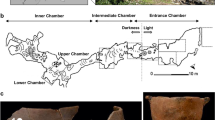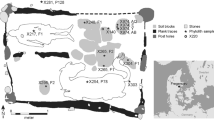Abstract
Bottle gourd (Lagenaria siceraria (Molina) Standl.) is accepted as typical ‘New World’ cultivated economic plant. Currently, two subspecies are known: L. siceraria ((Molina) Standl.) ssp. siceraria has an African origin, whilst ssp. asiatica is recognized to be originating from Asian territories. It only seldom appears in European archaeological contexts, however finds from the Roman period appear sporadically. Part of a Late Middle Age (14th–15th century) settlement was excavated near the town of Pócspetri (SE Hungary) and one of the refuse pits contained waterlogged remains of several dozen dicot leaves and small sized branches (e.g. Populus sp.). In addition an entire dog skeleton and an apparently 10 cm by 7 cm bottle gourd pericarp fragment were also found in a well-preserved pot. This fortunate recovery accounts for the first evidence of bottle gourd in the archaeobotanical record of Hungary and Eastern Europe. Due to its favourable preservation not only precise morphological analysis could be undertaken, but ancient DNA (aDNA) extraction, PCR amplification and sequencing were used to identify more closely its possible origin and taxonomic relations. Different diagnostic phytolith morphotypes of the pericarp were matched to reference material phytolith assemblages. The macro-archaeobotanical record of the feature reflects the botanical elements of the natural environment of this medieval site and places the unique bottle gourd find in context.













Similar content being viewed by others
References
Achigan Dako EG, Vodouhe SR, Sangare A (2008) Morphological characterization of cultivars of Lagenaria siceraria collected in Benin and Togo. Belg J Bot 141:21–38
Albert RM, Weiner S (2001) Study of opal phytoliths in prehistoric ash layers using a quantitative approach. In: Meunier J, Coline F (eds) Phytoliths: applications in earth sciences and human history. Balkema, Lisse, pp 251–266
Bertsch K (1927) Die Obstreste aus den Alamannengräbern von Oberflacht. Ber Dt Bot Ges 45:23–30
Bosi G, Mercuri AM, Guarnieri Ch, Bandini Mazzanti M (2009) Luxury food ornamental plants at the 15th century ad. Renaissance court of the Este family (Ferrara, northern Italy). Veget Hist Archaeobot 18:389–402
Bozarth SR (1987) Diagnostic opal phytoliths from rinds of selected Cucurbita species. Am Antiqu 53:607–615
Bradley RS, Jones PD (1992) Climatic variations over the last 500 years. In: Bradley RS, Jones PD (eds) Climate Science ad 1500. Routledge, London, pp 649–665
Brombacher C, Jacomet S (1997) Ackerbau, Sammelwirtschaft und Umwelt: Ergebnisse archäobotanischer Untersuchungen. In: Schibler J, Hüster-Plogmann H, Jacomet S, Brombacher C, Gross-Klee E, Rast-Eicher A (eds) Ökonomie und Ökologie neolithischer und bronzezeitlicher Ufersiedlungen am Zürichsee. Monographien der Kantonsarchäologie Zürich
Cioccale M (1999) Climatic fluctuations in the central region of Argentina in the last 1000 years. Quat Int 62:35–47
Cutler HC, Whitaker TW (1961) History and distribution of the cultivated Cucurbits in the Americas. Am Antiqu 26:469–485
Decker-Walters DS (1999) Cucurbits, sanskrit and the indo-aryans. Econ Bot 53:98–112
Decker-Walters DS, Wilkins-Ellert M, Chung SM, Staub JE (2004) Discovery and genetic assessment of wild bottle Gourd [Lagenaria siceraria (Mol.) Standley; Cucurbitaceae] from Zimbabwe. Econ Bot 58:501–508
Doran GH, Dickel DN, Newsom LA (1990) A 7,290-year-old bottle gourd from the windover site, Florida. Am Antiqu 55:354–360
Doyle JJ, Doyle JL (1987) A rapid DNA isolation procedure for small quantities of fresh leaf tissue. Phytochem Bull 19:11–15
Erickson DL, Smith BD, Clarke AC, Sandweiss DH, Tuross N (2005) An asian origin for a 10,000-year-old domesticated plant in the Americas. Proc Natl Acad Sci 102:18,315–18320
Fuller DQ, Hosoya LA, Zheng Y, Qin L (2010) A contribution to the prehistory of domesticated bottle gourds in Asia: rind measurements from Jomon Japan and Neolithic Zhejiang, China. Econ Bot 64:260–265
Fulton TL, Stiller M (2012) PCR amplification, cloning, and sequencing of ancient DNA. In: Shapiro BJ, Hofreiter M (eds) Ancient DNA. Humana Press, New York, pp 111–119
Gál-Mlakár V (2009) A 13-14. századi fehér kerámia kutatástörténete Északkelet-Magyarországon [The research history of 13th–14th century white ceramic in North Eastern Hungary]. Marisia 29:165–185
Gy Brecher (1960) A magismeret atlasza [The atlas of seed identification]. Mezőgazdasági Kiadó, Budapest
Gyulai F (2010) Archaeobotany in Hungary. Seed, fruit, food and beverage remains in the Carpathian Basin from the Neolithic to the Late Middle Ages. Archaeolingua Main Series 21. Archaeolingua Alapítvány, Budapest
Hartyányi PB, Nováki Gy (1973/74) Növényi mag- és termésleletek Magyarországon az újkőkortól a XVIII. sz.-ig II [Samen- und Fruchtfunde in Ungarn von der Jungsteinzeit bis zum XVIII. Jahrhundert II]. Magyar Mezőgazdasági Múzeum Közleményei, pp 23–73
Hartyányi PB, Nováki Gy, Patay Á (1967/1968) Növényi mag- és termésleletek Magyarországon az újkőkortól a XVIII. sz.-ig I [Samen- und Fruchtfunde in Ungarn von der Jungsteinzeit bis zum XVIII. Jahrhundert I]. Magyar Mezőgazdasági Múzeum Közleményei, pp 5–85
Heiser CB Jr (1973) Variation in the bottle gourd. In: Meggers BJ, Ayensu ES, Duckworth D (eds) Tropical forest ecosystems in Africa and South America: a comparative review. Smithonian Institution Press, Washington, pp 121–128
Heiser CB Jr (1985) Of plants and people. University of Oklahoma Press, Norman
Holl I (1956) Adatok a középkori magyar fazekasság munkamódszereihez [Data on Hungarian pottery methods of Middle Ages]. Bud Rég 17:177–194
Holl I (1963) Középkori cserépedények a budai várpalotából [Middle Age ceramic sherds for the Budavár Castle]. Bud Rég 20:335–394. https://en.wikipedia.org/wiki/Lagenaria. Accessed on 22 Sept 2015
Horváth F, Dobolyi KZ, Morschhauser T, Lőkös L, Karas L, Szerdahelyi T (1995) FLÓRA Adatbázis 1.2. [FLÓRA Database 1.2.]: Taxon-lista és attribútum-állomány [List of taxa and attributes]. Flóra Munkacsoport MTA Ökológiai és Botanikai Kutatóintézete és MTM Növénytár, Vácrátót, Budapest
Kenward HK, Hall AR, Jones AKG (1980) A tested set of techniques for the extraction of plant and animal macrofossils from waterlogged archaeological deposits. Sci Archaeol 22:3–15
Király G (ed) (2009) Új magyar füvészkönyv. Magyarország hajtásos növényei. Határozókulcsok [New Hungarian Herbal. The Vascular Plants of Hungary. Identification key]. Aggteleki Nemzeti Park Igazgatóság, Jósvafő
Kistler L, Montenegro Á, Smith BD, Gifford JA, Green RE, Newsom LA, Shapiro B (1980) Transoceanic drift and the domestication of African bottle gourd in the Americas. PNAS 111:2,937–2,941
Kooistra LI, Hessing WAM (1988) Ein frühmittelalterlicher Brunnen mit einer exotischen Frucht aus Houten. Berichten van de Rijksdienst voor het Oudheidkundig Bodemonderzoek 38:207–228
Lamb HH (1982) Climate, history and the modern world. Routledge, London
Lundström-Baudais K, Mignot C, Brunier C, Grudler A, Baudais D, Bidault M (1993) Le milieu végétal au XIe siècle: macrorestes et paléosemences. In: Colardelle M, Verdel E (eds) Les habitats du lac de Paladru (Isère) dans leur environnement. La formation d’un terroir au XIe siècle. Editions de la Maison des Sciences de l’Homme, Paris, pp 77–97
Madella M, Alexandre A, Ball T (2005) international code for phytolith nomenclature 1.0. Ann Bot 96:253–260
Maier U (2001) Archäobotanische Untersuchungen in der neolithischen Ufersiedlung Hornstaad-Hörnle IA am Bodensee. In: Maier U, Vogt R (eds) Siedlungsarchäologie im Alpenvorland VI. Botanische und pedologische Untersuchungen zur Ufersiedlung Hornstaad-Hörnle IA. Forsch Ber Vor- u Frühgesch Bad-Württ 74, Stuttgart, pp 9–384
Majerik V, Larsson N, Bóka G, Sóskuti K (2013) Pócspetri-Bikaréti szivárgó, M3212. In: Tájékoztató az MNM NÖK 2010–2011. Évi tevékenységéről [Pócspetri-Bikaréti szivárgó, M3212. In: 2010–2011 year book of the Hungarian National Museum National Heritage Protection Centre]. Budapest
Marosi S, Somogyi S (1990) Magyarország Kistájainak Katasztere [Geographical Regions of Hungary. Magyar Tudományos Akadémia, Földrajztudományi Kutató Intézet, Budapest
Mészáros O, Serlegi G (2011) The impact of environmental change on medieval settlement structure in Transdanubia. Acta Archaeol Acad Sci Hung 62:199–219
Morimoto Y, Maundu P, Fujimaki H, Morishima H (2005) Diversity of landraces of the white-flowered gourd (Lagenaria siceraria) and its wild relatives in Kenya: fruit and seed morphology. Gen Res Crop Evol 52:737–747
Paris HS (2016) Overview of the origins and history of the five major cucurbit crops: issues for ancient DNA analysis of archaeological specimens. Veget Hist Archaeobot. doi:10.1007/s00334-016-0555-1
Petényi S (1996) A középkor második felének kerámiája. A fazekasipar új elemei. In: Fülöp EA (ed) (Szerkesztette) A magyar kerámiaművesség ezer éve [Ceramics of the second half of the Middle Ages. New elements in pottery production. In: Fülöp EA (Bearbeiter) Thousand years of Hungarian pottery]. Tata, pp 23–28
Pfister Ch (1992) Monthly temperature and precipitation in central Europe from 1525 to 1979: quantifying documentary evidence on weather and its effects. In: Bradley RS, Jones PD (eds) Climate science ad 1500. Routledge, London, pp 118–142
Piperno DR, Holst I, Wessel-Beaver L, Andres TC (2002) Evidence for the control of phytolith formation in Cucurbita fruits by the hard rind (Hr) genetic locus: archaeological and ecological implications. PNAS 99:10923–10928
Rácz L (1993) Éghajlati változások a középkori és a kora újkori Európában [Climate change in Europe during Medieval Ages and in the beginning of the Early Modern Age]. In: R. Várkonyi Á, Kósa L (eds) (Szerkesztette) Európa híres kertje. Budapest, pp 67–86
Rácz L (1995) A Kárpát-medence éghajlattörténete a kora újkor idején [The climate history of the Carpathian Basin during Early Modern Age]. Történelmi Szemle 4:487–508
Radics L (1998) Gyommaghatározó [Weed seed identification]. Mezőgazda Kiadó, Budapest
Roberts KM (2015) Cucurbita spp. and Lagenaria siceraria (Molina) Standley. The laboratory guide to archaeological plant remains from eastern North America: advanced Paleoethnobotany Seminar (Anthropology 4214). http://pages.wustl.edu/fritz/cucurbita-spp.-and-lagenaria-siceraria-molina-standley. Accessed on 25 April 2015
Robinson RW, Decker-Walters DS (1997) Cucurbits. CAB International, New York
Rösch M (2008) New aspects of agriculture and diet of the early medieval period in central Europe: waterlogged plant material from sites in south-western Germany. Veget Hist Archaeobot 17(Suppl 1):S225–S238
Rösch M, Fischer E (2004) Außergewöhnliche pflanzliche Funde aus Alamannengräbern des sechsten Jahrhunderts von Trossingen (Kreis Tuttlingen, Baden-Württemberg). Arch Korrbl 34:271–276
Rottoli M, Pessina A (2007) Neolithic agriculture in Italy: an update of archaeobotanical data with particular emphasis on northern settlements. In: Colledge S, Conolly J (eds) The origins and spread of domestic plants in southwest Asia and Europe. Left Coast Press, Walnut Creek, pp 140–154
RTJ Cappers, RM Bekker, Jans JEA (2006) Digital seed atlas of the Netherlands [Digitale Zadenatlas van Nederland]. Groningen Archaeological Studies 4. Barkhuis, Groningen
Schlumbaum A, Vandorpe P (2012) A short history of Lagenaria siceraria (bottle gourd) in the Roman provinces: morphotypes and archaeogenetics. Veget Hist Archaeobot 21:499–509
Shah BN, Seth AK, Dosai RV (2010) Phytopharmacological profile of Lagenaria siceraria, A review. Asian J Plant Sci 9:152–157
Simonyi E (2005) Adatok a 10–13. századi kerámiakészítéshez Északkelet-Magyarországon [Data on 10–13th cent. pottery production of North Eastern Hungary]. Herman Ottó Múzeum Évkönyve 44:37–55
Simonyi E (2010) Adatok a késő Árpád-kori fehér kerámia kialakulásához [New Data on the development of the Late Árpádian Age whiteware]. In: Petkes Zs (ed) Hadak útján XX. Népvándorláskor Fiatal Kutatóinak XX. Összejövetelének konferenciakötete. Budapest-Szigethalom, 2010. Október 28–30. Budapest, pp 327–343
Stone R (2004) Iceland’s doomsday scenario? Science 306:1,278–1,281
Sz Schermann (1966) Magismeret I–II (Seed identification I–II). Akadémiai Kiadó, Budapest
Szilágyi V, Gál-Mlakár V, Rácz TÁ, Sajó I, Simonyi E (2010) 12–14. századi fehér kerámiákon végzett anyagvizsgálatok első eredményei és a továbblépés lehetőségei. Gesta 9:153–167
Villalba R (1994) Tree ring and glacial evidence for the medieval warm epoch and the Little Ice Age in Southern South America. Clim Chang 26:183–197
Whitaker TW (1981) Archeological Cucurbits. Econ Bot 35:460–466
Whitaker TW, Carter GF (1954) Oceanic drift of gourds—experimental observations. Am J Bot 41:697–700
Zama B (2000) Manufatti lignei del sito archeologico di via Vaspergolo-Corso Porta Reno (Ferrara-Nord Italia) datato X–XV sec. d.C. Analisi xilologiche e considerazioni di ordine ethnobotanico e floristico-vegetazionale. Masters thesis, University of Bologna, Bologna
Acknowledgments
The excavation leader at Pócspetri-Bikaréti szivárgó was Vera Majerik (HNM NCCH), while Gergely Bóka, Nicklas Larsson and Kornél Sóskuti of the same institution were participating archaeologists in the project; the authors are thankful to all of them for the careful and open-eyed excavation work. The authors are also grateful to two anonymous reviewers whose comments helped to improve this paper. This work was partly undertaken with the support of Research Centre of Excellence at Szent István University (9878/2015/FEKUT).
Author information
Authors and Affiliations
Corresponding author
Additional information
Communicated by A. Chevalier.
Electronic supplementary material
Below is the link to the electronic supplementary material.
Rights and permissions
About this article
Cite this article
Pető, Á., Kenéz, Á., Lisztes-Szabó, Z. et al. The first archaeobotanical evidence of Lagenaria siceraria from the territory of Hungary: histology, phytoliths and (a)DNA. Veget Hist Archaeobot 26, 125–142 (2017). https://doi.org/10.1007/s00334-016-0566-y
Received:
Accepted:
Published:
Issue Date:
DOI: https://doi.org/10.1007/s00334-016-0566-y




